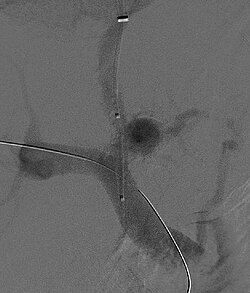Hepatorenal Syndrome
From WikiLectures
Hepatorenal syndrome is functional kidney failure in liver disease with portal hypertension. It occurs almost exclusively in patients with ascites.
Etiology and pathogenesis[edit | edit source]
The basis is systemic circulatory changes in portal hypertension.
- Renal arterial vasoconstriction (with cortical hypoperfusion) + damage to kidney functions,
- the basis is systemic circulatory changes in portal hypertension (↓ peripheral vascular resistance, central hypovolemia, sympathetic activation).
Clinical picture[edit | edit source]
- Type I – rapidly progressive, 2x ↑ serum creatinine within 2 weeks, prognosis is very poor,
- type II – slowly progressing, renal insufficiency occurs slowly + condition relatively stabilized.
Diagnostics[edit | edit source]
There is no specific test that can diagnose hepatorenal syndrome. Glomerular filtration is usually < 0.66 ml/s (40 ml/min), serum creatinine > 135 μmol/l, sodium in urine < 10 mmol/l, urine osmolality > plasma.
Differential diagnosis[edit | edit source]
- Organic kidney damage (ATN, etc.).
Terapy[edit | edit source]
- Exclusions: nephrotoxic drugs, diuretics, nonsteroidal antiphlogistics,
- treat bacterial infection, rule out bleeding in the gastrointestinal tract,
- correction of hypovolemia (albumin, terlipressin),
- TIPS (days to weeks apart,
- liver transplant.
Links[edit | edit source]
Related articles[edit | edit source]
References[edit | edit source]
- DÍTĚ, P.. Vnitřní lékařství. 2. edition. Galén, 2007. ISBN 978-80-7262-496-6.




